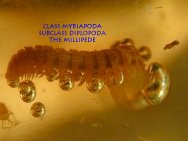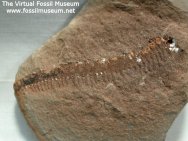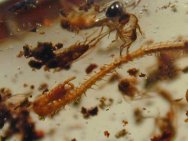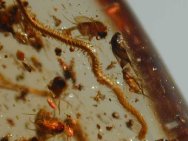Class Myriapoda Fossil Gallery
Myriapoda
Fossils: Diplopoda (the millipedes) Chilopoda (the centipedes) Pauropoda Symphyla | Page
within: |
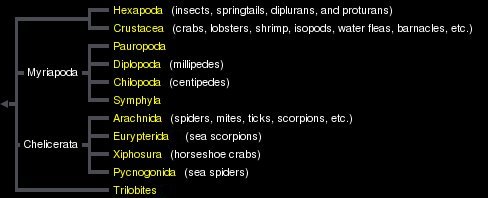 Class
Myriapoda includes four
subclasses. Diplopoda (the millipedes) and Chilopoda (the centipedes) are names
familiar to most people. The two other subclasses, Pauropoda and Symphyla, comprise
more elusive creatures of dim, protected places such as leaf litter and dirt.
Myriapods are most noted for having many legs (ranging from <10 to a couple
hundred pairs) and there are some 13,000 extant species. Many species have glands
that secrete foul-tasting compounds as a chemical defense. Class
Myriapoda includes four
subclasses. Diplopoda (the millipedes) and Chilopoda (the centipedes) are names
familiar to most people. The two other subclasses, Pauropoda and Symphyla, comprise
more elusive creatures of dim, protected places such as leaf litter and dirt.
Myriapods are most noted for having many legs (ranging from <10 to a couple
hundred pairs) and there are some 13,000 extant species. Many species have glands
that secrete foul-tasting compounds as a chemical defense. Chilopoda (centipedes) have one pair of legs per body segment, are predators, and the first pair of are claws with poison glands that they use to capture prey. Diplopoda (meaning double legs) include the millipedes. Each body segment is formed in early development when two adjacent embryonic segments fuse, resulting in each adult body segment having two pairs of legs. While some are carnivores, most feed on decaying vegetation. There are four groups of myriapods; how they are related to each other is not yet well understood. Two of them, the Symphyla and Pauropoda, consist of tiny arthropods living in leaf litter and soil; both superficially resemble centipedes. Symphylans are lowly cousins of centipedes, and Pauropodans more closely resemble millipedes. Symphylans are eyeless, .5 to 8 mm, have 14 segments of which the first twelve have pairs of legs. The Pauropods are also eyeless, are a tiny .5 to 1.5 mm, with only 9 to 11 segments, some of which are diplo-segments, like millipedes. Lack of site renders these arthropods to a lowly existence. All Myriapods are relatively rare in the fossil record, a result of a light and thin cuticle shell, and their existence in non-marine environments where fossilization is less likely. The few older fossils, however, are testament to the ancient appearance of these Arthropods. The oldest fossil uniramians (single-jointed legs) are Myriapod-like marine creatures from Cambrian-age strata. Fossil burrows in Ordovician strata have led to conjecture that Myriapods might have been living on land as early as 400 million years ago. However, some of the first unequivocal terrestrial myriapods are recorded from rocks of the Late Silurian and the oldest centipedes are from the Devonian. Fossil millipedes are found in the famous Pennsylvanian-age Mazon Creek site in Northern Illinois. Cenozoic examples are known primarily from Oligocene amber. Mesozoic myriapod fossils are quite rare. Myriapodous arthropods have been discovered in the Rhynie chert where they appear to have formed a significant component of the Early Devonian biota. The oldest myriapod in the fossil record, and possibly the oldest known terrestrial oxygen-breathing organism is the millipede Pneumodesmus newmani from the mid Silurian dating to about 425 million years ago (Wilson and Anderson, 2004). It exhibits cuticular openings that taxonomists have interpreted as spiracles, or atmospheric oxygen intake organs. The oldest centipede in the fossil record is described from macerates, or cuticle remnants from hydrofluoric acid-dissolved rocks, of the Late Silurian, dating to about 415 million years ago (Jeram, et al. 1990). Jeram,
A. J., Selden, P. A. and Edwards, D. 1990. Land animals in the Silurian:
arachnids and myriapods from Shropshire, England. Science, 250,
658-661.
| ||||||||||||||||||
|
Fossil
Museum Navigation:
Home Geological Time Paleobiology Geological History Tree of Life Fossil Sites Fossils Evolution Fossil Record Museum Fossils |

